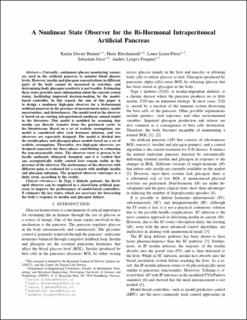| dc.contributor.author | Davari Benam, Karim | |
| dc.contributor.author | Khoshamadi, Hasti | |
| dc.contributor.author | Lema-Pérez, Laura | |
| dc.contributor.author | Gros, Sebastien | |
| dc.contributor.author | Fougner, Anders Lyngvi | |
| dc.date.accessioned | 2023-01-19T13:20:58Z | |
| dc.date.available | 2023-01-19T13:20:58Z | |
| dc.date.created | 2022-09-14T08:58:27Z | |
| dc.date.issued | 2022 | |
| dc.identifier.isbn | 978-1-7281-2783-5 | |
| dc.identifier.uri | https://hdl.handle.net/11250/3044650 | |
| dc.description.abstract | Currently, continuous glucose monitoring sensors are used in the artificial pancreas to monitor blood glucose levels. However, insulin and glucagon concentrations in different parts of the body cannot be measured in real-time, and determining body glucagon sensitivity is not feasible. Estimating these states provides more information about the current system status, facilitating improved decision-making by the model-based controller. In this regard, the aim of this paper is to design a nonlinear high-gain observer for a bi-hormonal artificial pancreas in the presence of measurement noises, model uncertainties, and disturbances. The model used in the observer is based on an existing intraperitoneal nonlinear animal model in the literature. This model is modified by assuming that insulin can directly transfer from the peritoneal cavity to the bloodstream. Based on a set of realistic assumptions, one model is considered after each hormone infusion, and two observers are separately designed. The model is divided into the insulin-phase and glucagon-phase models based on a set of realistic assumptions. Thereafter, two high-gain observers are designed separately for these phases contributing to estimating the non-measurable states. The observer error is proven to be locally uniformly ultimately bounded, and it is verified that any asymptotically stable control laws remain stable in the presence of the observer. The performance of the observers with different gains is evaluated for a scenario with multiple insulin and glucagon infusions. The proposed observer converges to a finite error, according to the results. Clinical relevance- In Type 1 diabetic patients, the developed observer can be employed in a closed-loop artificial pan-creas to improve the performance of model-based controllers. It estimates the key states, which are necessary for forecasting the body's response to insulin and glucagon boluses. | en_US |
| dc.language.iso | eng | en_US |
| dc.publisher | IEEE | en_US |
| dc.relation.ispartof | Proceedings of the 44th Annual International Conference of the IEEE Engineering in Medicine & Biology Society (EMBC 2022) | |
| dc.relation.uri | https://doi.org/10.1109/EMBC48229.2022.9871264 | |
| dc.subject | Kunstig bukspyttkjertel | en_US |
| dc.subject | Artificial Pancreas | en_US |
| dc.subject | Peritoneum | en_US |
| dc.subject | Peritoneum | en_US |
| dc.subject | Automatisk glukoseregulering | en_US |
| dc.subject | Closed loop glucose control | en_US |
| dc.subject | Tilstandsestimator | en_US |
| dc.subject | State observer | en_US |
| dc.title | A Nonlinear State Observer for the Bi-Hormonal Intraperitoneal Artificial Pancreas | en_US |
| dc.title.alternative | A Nonlinear State Observer for the Bi-Hormonal Intraperitoneal Artificial Pancreas | en_US |
| dc.type | Chapter | en_US |
| dc.description.version | acceptedVersion | en_US |
| dc.rights.holder | © IEEE. Personal use of this material is permitted. Permission from IEEE must be obtained for all other uses, in any current or future media, including reprinting/republishing this material for advertising or promotional purposes, creating new collective works, for resale or redistribution to servers or lists, or reuse of any copyrighted component of this work in other works. | en_US |
| dc.subject.nsi | VDP::Medisinsk teknologi: 620 | en_US |
| dc.subject.nsi | VDP::Medical technology: 620 | en_US |
| dc.subject.nsi | VDP::Medisinsk teknologi: 620 | en_US |
| dc.subject.nsi | VDP::Medical technology: 620 | en_US |
| dc.source.pagenumber | 171-176 | en_US |
| dc.identifier.doi | 10.1109/EMBC48229.2022.9871264 | |
| dc.identifier.cristin | 2051501 | |
| dc.relation.project | Norges forskningsråd: 248872 | en_US |
| cristin.ispublished | true | |
| cristin.fulltext | postprint | |
